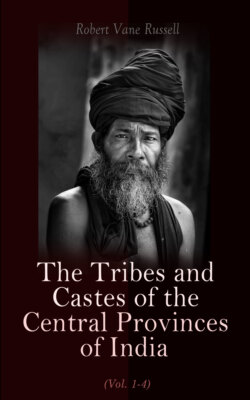Читать книгу The Tribes and Castes of the Central Provinces of India (Vol. 1-4) - Robert Vane Russell - Страница 25
Vām-Mārgi, Bām-Mārgi, Vāma-Chari Sect.
ОглавлениеVām-Mārgi, Bām-Mārgi, Vāma-Chari Sect.1—A sect who follow the worship of the female principle in nature and indulge in sensuality at their rites according to the precepts of the Tāntras. The name signifies ‘the followers of the crooked or left-handed path.’ Their principal sacred text is the Rudra-Yamal-Damru Tāntra, which is said to have been promulgated by Rudra or Siva through his Damru or drum at the end of his dance in Kailās, his heaven in the Himalayas. The Tāntras, according to Professor Monier-Williams, inculcate an exclusive worship of Siva’s wife as the source of every kind of supernatural faculty and mystic craft. The principle of female energy is known as Sakti, and is personified in the female counterparts of all the Gods of the Hindu triad, but is practically concentrated in Devi or Kāli. The five requisites for Tantra worship are said to be the five Makāras or words beginning with M: Madya, wine; Mānsa, flesh; Matsya, fish; Mudra, parched grain and mystic gesticulation; and Maithuna, sexual indulgence. Among the Vām-Mārgis both men and women are said to assemble at a secret meeting-place, and their rite consists in the adoration of a naked woman who stands in the centre of the room with a drawn sword in her hand. The worshippers then eat fish, meat and grain, and drink liquor, and thereafter indulge in promiscuous debauchery. The followers of the sect are mainly Brāhmans, though other castes may be admitted. The Vām-Mārgis usually keep their membership of the sect a secret, but their special mark is said to be a semicircular line or lines of red powder or vermilion on the forehead, with a red streak half-way up the centre, and a circular spot of red at the root of the nose. They use a rosary of rudrāksha or of coral beads, but of no greater length than can be concealed in the hand, or they keep it in a small purse or bag of red cloth. During worship they wear a piece of red silk round the loins and decorate themselves with garlands of crimson flowers. In their houses they worship a figure of the double triangle drawn on the ground or on a metal plate and make offerings of liquor to it.
Image of the boar incarnation of Vishnu
They practise various magical charms by which they think they can kill their enemies. Thus fire is brought from the pyre on which a corpse has been burnt, and on this the operator pours water, and with the charcoal so obtained he makes a figure of his enemy in a lonely place under a pīpal tree or on the bank of a river. He then takes an iron bar, twelve finger-joints long, and after repeating his charms pierces the figure with it. When all the limbs have been pierced the man whose effigy has been so treated will die. Other methods will procure the death of an enemy in a certain number of months or cause him to lose a limb. Sometimes they make a rosary of 108 fruits of the dhatūra2 and pierce the figure of the enemy through the neck after repeating charms, and it is supposed that this will kill him at once.
1 This article is based on Professor Wilson’s Hindu Sects, M. Chevrillon’s Romantic India, and some notes collected by Munshi Kanhya Lal of the Gazetteer Office.
2 Dhatura alba, a plant sacred to Siva, whose seed is a powerful narcotic, and is used to poison travellers.
